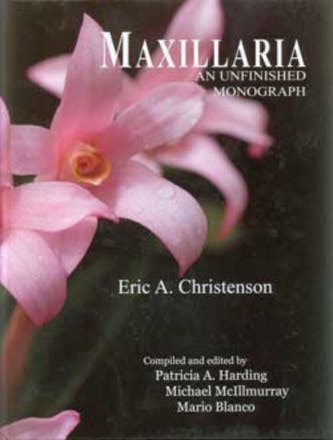When Eric Christenson died unexpectedly in 2011, he was actively working on a taxonomic revision of Maxillaria, a taxonomically confusing genus of over 600 species. He left a rough manuscript and a large number of files and photographs. Encouraged by Eric’s brother, Patricia Harding undertook the huge task of organizing the information into publishable shape; these two volumes are the result. The text is largely that of Christenson, but with commentary and supplementation (highlighted in blue) by Harding, McIllmurray, and Blanco. McIllmurray curates the UK National Plant Collection® of Maxillarias. He provided line drawings of many species in his collection and sent the illustrations to Christenson for determination; these illustrations are included in the volumes. Mario Blanco is a botanist at the Universidad de Costa Rica with an extensive knowledge of the Maxillaria subtribe; he vetted photos and illustrations against Christenson’s species concepts, checked nomenclature and synonymy and provided valuable commentary.
A disclaimer: I should acknowledge that I am not a completely objective reviewer. By the time of his death, Eric had alienated himself from the majority of orchid taxonomists; agreeing to disagree pleasantly was not one of his best traits, and I was among many with whom he had terminated polite communication. That aside, these volumes are a remarkable compendium of valuable information unequalled in any other single source, and they are a valuable resource for both botanists and orchid hobbyists.
If you grow Maxillarias and related genera and are interested in identifying plants and learning more about them, these volumes are the best place to start. Essentially, the volumes are an alphabetical compendium of Maxillaria species from A to Z, with nomenclatural information, species description, general distribution, discussion, and photographs and illustrations. Type information is presented for many species (often with images of the type), but lists of actual herbarium specimens examined and distribution maps are absent. The treatment of each species varies widely in quality, depending upon the resources that Christenson could find. He was neither an orchid grower nor photographer/illustrator, and so his treatments are compiled from herbarium specimens and botanical literature, accompanied by photographs and drawings contributed by friends. There is no dichotomous key to identification of Maxillaria species, so leafing through the alphabetical treatment is the only way to identify unknown species. For commonly cultivated species, e.g., M. tenuifolia, there are several photographs and a variety of drawings. The treatments for some rare species consist only of text and a crude drawing of a flower or photograph of a herbarium specimen. In many cases, all we know of a species is the type specimen and its original description. Orchid hobbyists are naturally predisposed to emphasize the flowers of a plant and often ignore vegetative features. Unfortunately, in Maxillaria sensu Christenson, vegetative features vary enormously and are as important as floral traits in the identification of an unknown. The authors have done their best to include images or drawings of whole plants or vegetative features, but the uneven quality of images will be challenging to orchid hobbyists.
Eric favored a wide circumscription of Maxillaria, and his circumscription is followed in these books. His classification differs from newer generic circumscriptions proposed by Whitten, Blanco, Carnevali, and coworkers based on DNA sequence data and morphology and adopted by the Genera Orchidacearum book series from Royal Botanic Gardens, Kew. The Blanco et al. classification divides Eric’s broad Maxillaria into Brasiliorchis (or Bolbidium), Camaridium, Christensonella, Heterotaxis, Inti, Mapiguari, Maxillariella, Mormolyca, Nitidobulbon, Ornithidium, Pityphyllum, Rhetinantha, Sauvetrea, plus a Maxillaria sensu stricto. There is only partial correspondence between these genera and Christenson’s proposed sections within Maxillaria sensu lato; many of his sections are paraphyletic (“artificial”) according to cladistic analysis of DNA data. This discordance in classification systems creates confusion as to which name should properly be used for a particular species; for example, the page for Maxillaria equitans lists eight synonyms in four different genera. With few exceptions, one can search the name in World Flora Online (WFO) to find the name currently accepted by taxonomists (in this case, it is Heterotaxis equitans). For Central American species, Lankester Garden’s database is authoritative and often includes superb photographs and illustrations.
In some genera or sections, Eric’s treatments have been superseded by more careful revisionary and phylogenetic studies by botanists. Examples include Christensonella (=Maxillaria sect. Urceolatae Christenson), revised by Samantha Koehler (Univ. São Paulo), and Mormolyca (=Maxillaria sect. Rufescens Christenson + Mormolyca sensu stricto), under revision by Rafael Arévalo (Univ. of Wisconsin). This is not to denigrate Eric’s contributions, but to point out that concepts change as we learn more about plants, and that the names and species concepts in these volumes should not be viewed as final and authoritative.
Despite these caveats, these volumes are essential for any serious academic or orchid library. If you love Maxillarias, these books will help you appreciate the plants that you grow, as well as give you a window into the huge diversity of species that are not in cultivation. Most importantly, they will serve as helpful starting point for serious orchid students who wish to study a group in greater detail.
A final note: In her introduction, Patricia Harding states that Eric’s files and photographs (including images of many types) have been deposited at the University of Florida. The files are temporarily stored at UF, but they are destined for permanent storage in the AOS library at Fairchild Tropical Gardens.
Mark Whitten, Ph.D.
Florida Museum of Natural History
Gainesville, FL 32611-7800
whitten@flmnh.ufl.edu






